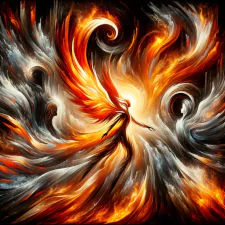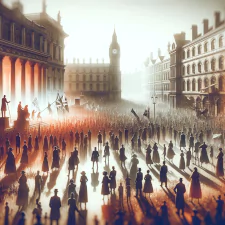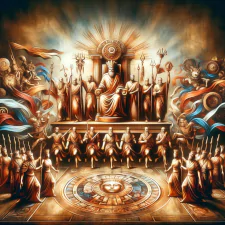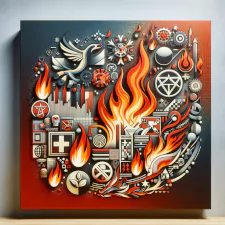Visual and Symbolic Dehumanization
The role and symbolism of fire in the Nazi book burnings served as a chilling tool for visual and symbolic dehumanization, integral to the regime’s strategy of persecution and dominance. The act of book burning, more than the physical destruction of materials, was a deliberate communication tool.
It projected ideologies of hatred, inferiority, and rejection toward targeted groups, vividly illustrating the Nazi regime’s contempt for divergent thoughts and communities. This detailed analysis delves deeper into how book burnings became a symbol of ideological warfare, targeting not just books but the very essence of cultural and intellectual diversity.
Key Takeaways
- Symbolic Destruction: Fire symbolized the Nazis’ desire to destroy and purify society from “undesirable” ideas, reinforcing their ideological narrative.
- propaganda Tool: The visual spectacle of book burnings, amplified by media, was a powerful tool for Nazi propaganda, spreading fear and enforcing conformity.
- Public Involvement: Public participation in book burnings deepened personal investment in Nazi ideology, creating a more controlled and homogenous society.
Table of Contents
- Book Burnings and Ideological Warfare in Nazi Germany
- Public Participation in the Symbolism of Fire and Book Burnings
- Targeted Selection of Works for Fire: Symbolic Exclusion in Nazi Book Burnings
- Propaganda Facilitated by Fire: The Symbolic Use of Book Burnings in Nazi Rhetoric
- Conclusion:
- Frequently Asked Questions
Book Burnings and Ideological Warfare in Nazi Germany
In my article The Propaganda of Nazi Book Burning: Why it’s Important. We looked at the causes of what led Germany down the path to these fiery acts. In this article, we will discuss the power behind the fire and the further actions to dehumanize people. The Nazis found a potent symbol for their crusade against intellectualism and diversity.
- Each book thrown into the flames represented not just the physical annihilation of ‘undesirable’ knowledge, but also the extinguishing of alternative ideologies and histories.
Engineered to instill a monolithic cultural narrative, aligning with the Nazi agenda of erasing pluralistic thought and reinforcing a singular, oppressive worldview. Carefully orchestrated for public spectacles designed to intimidate and indoctrinate. Serving as a stark reminder of the regime’s power and ideological rigidity.
Imagery and Symbolism of Fire in Nazi Book Burnings: The Power of Visual Spectacle

Visual Spectacle: Designed to captivate and influence the public book burnings were not merely acts of censorship. Rather they were grand spectacles accompanied by rallies and speeches. More importantly, these events were choreographed to leave a lasting impression on the masses. Namely, the dramatic visual of flames consuming books was intended to be both shocking and awe-inspiring, serving as a powerful tool for propaganda.
Media Dissemination: The use of media played a crucial role in amplifying the impact of these events. Photographs and narratives of the book burnings were widely disseminated through newspapers, newsreels, and other forms of media. This ensured that the imagery and symbolism of these acts reached far beyond those physically present, embedding the message into the broader public consciousness. The strategic use of media helped to create a pervasive atmosphere of fear and conformity.
The Fiery Symbolism in Nazi Book Burnings: Destruction, Purification, and Transformation

Destruction and Purification: Fire in these events symbolized not just the physical destruction of books but also a metaphorical cleansing of German society. The Nazis aimed to eliminate what they deemed ‘un-German’ or ‘degenerate’ ideas, using fire as a purifying force to eradicate these influences.
Transformation and Renewal: The act of burning books also served as a symbol of transformation, signifying a break from the past and the creation of a new German society. This transformative symbolism was aligned with Nazi ideals of a reborn, powerful Germany, free from the influences they considered corrupt or degenerate.
Asserting Ideological Dominance: By publicly burning books, the Nazis sought to assert their ideological dominance. The fire served as a stark, tangible demonstration of the regime’s power to define what was acceptable in literature, culture, and thought.
Eradication of Dissent: The burning of books was also a powerful symbol of the eradication of dissenting voices. By destroying the works of Jewish, communist, liberal, and other authors, the regime sought to eliminate alternative viewpoints and enforce ideological conformity.
Public Participation in the Symbolism of Fire and Book Burnings
Collective Action: Public participation in book burnings was a key element in creating a sense of collective identity and action. By encouraging people to participate in these events, the Nazis fostered a communal atmosphere of involvement in their ideological mission. This participation was not just about witnessing the act but being an active part of it, which helped to solidify the regime’s messages in the minds of the participants.

Personal Investment and Indoctrination: Participation in book burnings also served to deepen personal investment in Nazi ideology. Being physically involved in the act of burning books representing ‘undesirable’ ideas, participants were more likely to internalize the beliefs and values promoted by the regime. This active involvement was a form of indoctrination, reinforcing the ideological messages and creating a more homogenous, controlled society.
Devaluing Intellectual Contributions: The Symbolic Fire of Nazi Book Burnings
Rejection of Ideas: The Nazi book burnings symbolized a forceful rejection of diverse intellectual contributions. By burning books from Jewish, leftist, and other non-conforming authors, the regime not only destroyed physical objects but also sought to erase the ideologies and knowledge contained within these works. This act was a public renouncement of the values and ideas represented in these books.

Demonstrating Contempt: The burning of books was a visible demonstration of contempt for the ideas and identities associated with the works. It was a way for the Nazis to publicly denounce and devalue the cultural and intellectual contributions of entire groups, particularly those they deemed as enemies or threats to their ideology. This symbolic act was a clear message of ideological intolerance and cultural domination.
Ceremonial Aspects of Fire in Nazi Book Burnings: Ritualistic and Theatrical Dimensions

Ritualistic Undertones: The orchestrated nature of Nazi book burnings gave them a ritualistic quality. These events were more than acts of censorship; they were ceremonies symbolizing the cleansing of the German intellectual sphere. The ritualistic aspect reinforced the perceived sanctity and importance of the ideologies being promoted.
Orchestrated Performances: Book burnings were meticulously planned and executed, similar to theatrical performances. They were designed to convey specific messages, evoke emotional responses, and reinforce the narrative of the Nazi regime. The theatricality of these events heightened their impact, making them memorable spectacles in the public consciousness.
Targeted Selection of Works for Fire: Symbolic Exclusion in Nazi Book Burnings

Focus on Specific Groups: The books selected for burning were not chosen at random. They were deliberately targeted based on authorship or content, often focusing on works by Jewish authors, communists, or others deemed undesirable by the Nazis. This selection process was a clear act of symbolic aggression against specific groups, reinforcing their marginalization.
Explicit Messages: By targeting specific books, the Nazis sent explicit messages about who and what they considered enemies or undesirable elements in society. This act was a public declaration of the ideologies and groups that the regime sought to suppress and eliminate from cultural and intellectual discourse.
Propaganda Facilitated by Fire: The Symbolic Use of Book Burnings in Nazi Rhetoric

Enhancing Narratives: The book burnings were a potent tool in the Nazi propaganda machine. These events, rich in symbolism and visually impactful, were used to reinforce the regime’s narratives. They facilitated the spread of propaganda by providing powerful, emotionally charged imagery that resonated with the public.
Emotional Manipulation: This not only enhanced the narratives but also played a key role in emotional manipulation. By stoking fear and hatred, the Nazis effectively used these images to solidify their control and further their ideological goals.
Conclusion:
Visual and symbolic dehumanization through book burning was a multifaceted strategy, tapping into the potent communicative powers of imagery and symbolism. It wasn’t merely an act of censorship but a performance carefully crafted to convey the Nazis’ ideological messages, devalue targeted groups, and manipulate societal sentiments.
The visual spectacle of fire-consuming books, coupled with the orchestrated participation of the public, created powerful symbols that facilitated the dehumanization and demonization integral to the Nazis’ oppressive regime.
In a modern echo, we witness the curtains rising on a different stage: the theater of book banning in contemporary society. While the fires may not physically blaze with the same ferocity, the symbolic embers smolder with familiar foreboding.
Today’s acts of book banning, albeit cloaked in different justifications, carry an echo of the past’s theatrical disdain for diverse narratives and ideas. The modern spectacle unfolds not in squares filled with fire but in debates, policies, and actions that seek to silence select stories, indirectly stoking the flames of ignorance and prejudice.
In reflecting upon these two acts, from history and the present, the continuity of symbolism and theatricality in censorship unfolds—a poignant reminder of the persistent shadows and the essential vigilance required to keep the flames of intolerance at bay.
Frequently Asked Questions
Why was fire used symbolically in Nazi book burnings?
Fire was used to symbolize destruction, purification, and transformation, representing the eradication of “undesirable” ideas and the creation of a new ideological order.
What impact did the Nazi book burnings have on society?
The book burnings served as a powerful propaganda tool, intimidating the public, enforcing ideological conformity, and demonstrating the regime’s power.
How were book burnings used as propaganda?
The Nazis used media to amplify the visual impact of book burnings, spreading fear and reinforcing their ideological messages through dramatic public spectacles.
What was the significance of public participation in book burnings?
Public participation fostered a sense of collective identity and deeper personal investment in Nazi ideology, solidifying the regime’s control.
How did book burnings target intellectual contributions?
By destroying books from Jewish, communist, and other non-conforming authors, the Nazis aimed to erase diverse ideologies and intellectual contributions, reinforcing their ideological dominance

Hi, i feel that i saw you visited my blog thus i came to go back the prefer?.I’m attempting to in finding issues to enhance
my web site!I guess its adequate to make use of some of your concepts!!